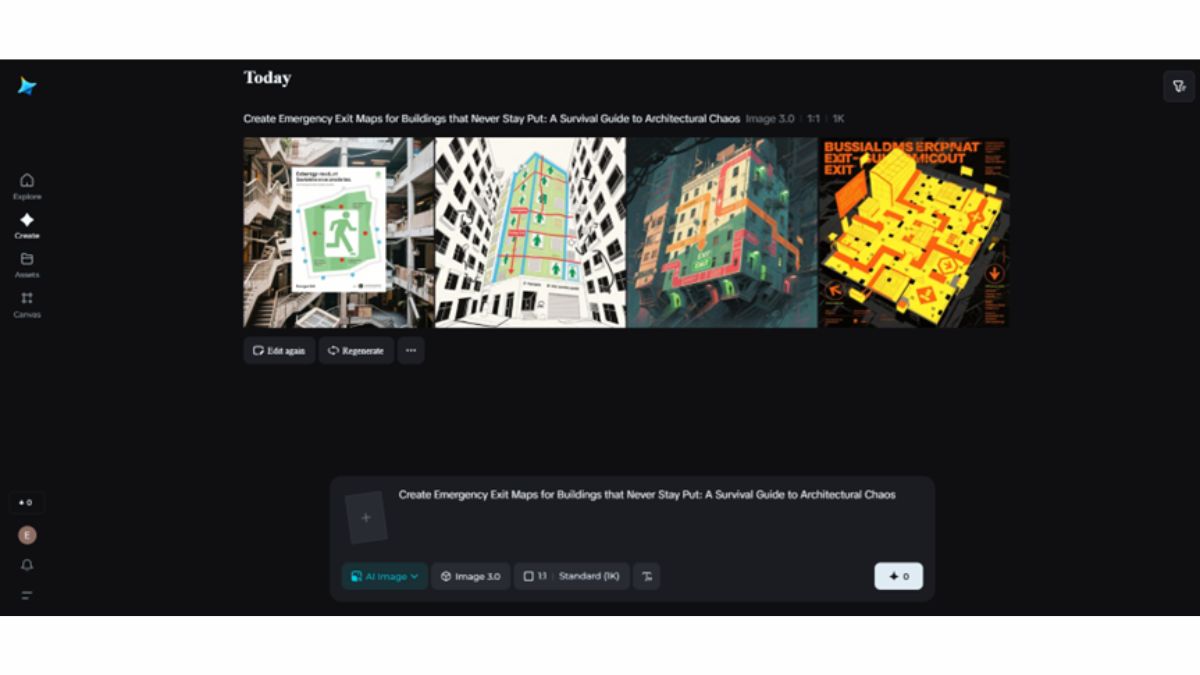New Delhi [India], July 22: Think about entering a building whose corridors curl and stretch like molten glass, whose staircases pirouette and are swallowed up behind swinging walls, and where every door opens up somewhere different, or nowhere familiar. Welcome to the age of self-reorganizing architecture, where the very floor plan of a structure is as ephemeral as your morning coffee high.
Think about having to locate an emergency exit in that morphing maze. Panic would already be in effect if you had a map printed out five minutes prior, and then you find the corridors have already reorganized. Classic exit plans turn into useless trinkets, rendered obsolete before they even reach the printer tray. But despite how confusing these buildings are, human creativity is never far behind.
Let’s take a stroll through this architectural chaos and see how Dreamina’s AI photo generator can navigate and even love these constantly shifting spaces!
The disappearing exit: why static maps in traditional buildings do not work
In traditional architecture, exit maps during emergencies are static, wall-mounted or printed, carefully laid out to lead the occupants to safety. These charts presume that doors remain static, staircases remain where you think, and walls do not open up or shut down unexpectedly.
But in buildings that have minds of their own — spaces that change shape at all hours, corridors wind around each other, and floors reconfigure in the dead of night — a printed emergency map is akin to a treasure map inscribed in invisible ink.
Print it for extra efficiency
By the time you’ve printed it, the exit you’ve committed to memory might be behind a wall that’s newly constructed or traded places with a service elevator shaft. These are the kinds of situations where static signage becomes not only useless, but hazardous.
Picture a theater with backstage corridors that change daily, or a laboratory whose layout changes by the hour to maximize space. These environments require something smarter, more flexible, and more dynamic than a laminated sheet of paper.

Living blueprints: when maps breathe and move with you
Welcome to the era of dynamic wayfinding systems — interactive, AI-based emergency maps that adapt in real-time. Picture a digital screen near an exit that immediately changes to show you the current configuration of the building, directing you to the safest path regardless of how the architecture shifts around you.
Emergency exit signs
With the advancements in AI, one is now able to implement an image generator that produces bespoke visual guides in real time. Emergency exit signs can become dynamic diagrams, casting arrows and routes calibrated to the current shape of the building and obstructions. Such maps do not simply indicate exits; they learn from pedestrian traffic patterns, sensor feeds, and even your travels to predict and guide your most secure route out.

Mobile phones and other devices as a vessel of choice
You could even use your smartphone as a personal navigation companion. Your device could create a live, augmented-reality escape route by synchronising with the building’s internal mapping system, superimposing directions onto the hallways you’re currently traversing. Printing maps that eventually become obsolete is becoming obsolete.
Branding chaos: from logos to artworks that shift with space
In reinventing buildings, it’s not only exit maps that should be malleable — all aspects of signage and branding should be as well. Old-fashioned logos and non-changing signs become meaningless when they’re plastered on walls that might cease to exist or move.
Logos for the perfect signs
Innovators are utilizing Dreamina’s AI logo generator to create modular brand elements that can change their shape, color, or position based on context. Consider a logo that subtly changes its design to show different zones or emergency states in the building, assisting occupants to unconsciously navigate even while the surroundings change around them.

Sketch it and pick it
Dreamina’s free AI art generator, also, is a necessary utility. But not the kind of sticky paper you rip off and throw away. We’re referring to digital sticker overlays projected onto walls and floors — dynamic, informative icons that pop up and fade as hallways change. These constantly updated visual cues assist in keeping people oriented and familiar with what’s around them during periods of architectural change.

Psychological architecture: soothing minds in an era of transition
In addition to the technical issue, there’s the psychological one. Humans need certainty — we ask for firm landmarks and well-defined routes when moving through space, particularly in the case of an emergency. In a building that’s constantly reconfiguring, staying calm is a formidable task.
Designers are investigating the incorporation of soothing visual language into shifting signage and fluid maps. The digital emergency guides are accompanied by soft colours, smooth animations, and calming sound cues that help to calm people and build confidence in the wayfinding system. Residents can feel secure even amid chaos if the architecture is designed to feel more like an adaptable companion than a trap.
When the building learns: AI’s role in architectural survival
Behind the scenes, AI functions as architect and caretaker. It oversees sensor networks, monitors occupancy, scans for hazards, and dynamically updates the building’s spatial model in real time. The information is input to the emergency mapping system, which is capable of predicting bottlenecks or hazardous areas and dynamically re-routing evacuees.
The image generator AI plays a vital role here, constantly creating new images that depict current routes, barriers, and doors. The building itself is an intelligent system, walls and signs cooperating to keep individuals safe.
Beyond escape: playful navigation in a shifting world
It’s easy to imagine these structures as simple dangers to flee from. But fluid architecture also calls out for new ways of interaction and play. Picture scavenger hunts or art experiences that employ changeable spaces as canvases, with artworks and logos created by AI turning the spaces into a living exhibit.

Emergency exit maps could also serve as interactive games or storytelling tools, inviting inhabitants to learn and appreciate the idiosyncrasies of the building before a real crisis occurs. This converts a survival requirement into an experience that fosters contact and imagination.
Mapping the unmappable
Exploring a building that reconfigures itself continuously defies all we believe we understand about space, safety, and signage. Static maps become useless in such dynamic architectures, but emerging technologies such as AI image generators, AI logo generators, and digital artwork makers are leading to the development of flexible, living navigation systems.
Ultimately, these structures remind us that security does not derive from fixity but from adaptability, resiliency, and creativity.
Conclusion
By accepting the turbulence with smart design and interactive devices, we may transform architectural uncertainty from a threat into a new frontier for human creativity and exploration.
Next time you step into a changing space, keep this in mind: the map can shift, but your sense of navigation is adapting as well — and it’s only becoming smarter.
If you object to the content of this press release, please notify us at pr.error.rectification@gmail.com. We will respond and rectify the situation within 24 hours.


